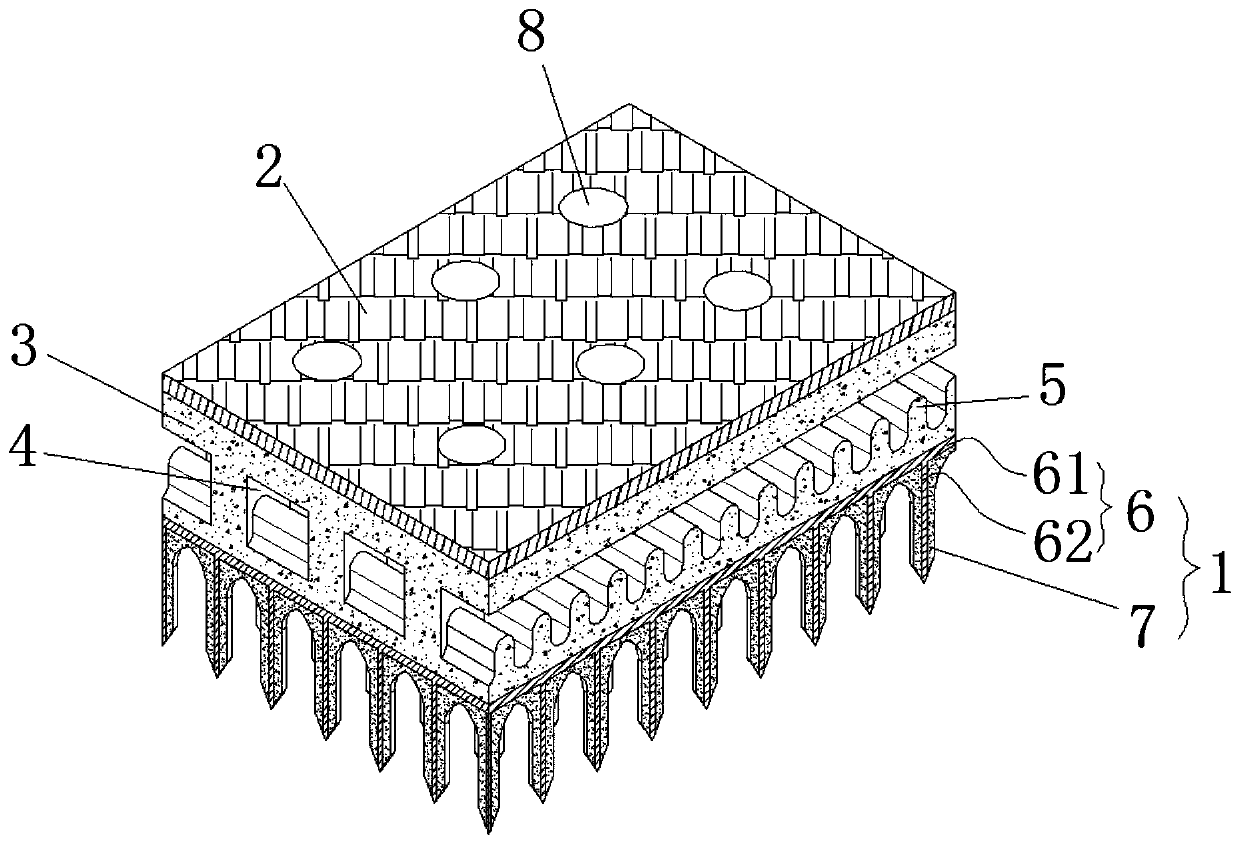Riverbed sediment in-situ remediation blanket and riverbed sediment remediation method
An in-situ restoration and river bed sediment technology, applied in the field of environmental governance, can solve problems such as the inability of microorganisms to survive, a large amount of clean sediment, and a large amount of engineering, so as to shorten the governance cycle, avoid secondary pollution, and improve the effect of restoration
- Summary
- Abstract
- Description
- Claims
- Application Information
AI Technical Summary
Problems solved by technology
Method used
Image
Examples
Embodiment 1
[0038] refer to figure 1 , an in-situ restoration blanket of riverbed bottom mud, comprising a bottom mud restoration layer 1, an aquatic plant layer 2 and a matrix layer 3, the bottom mud restoration layer 1 is used for repairing the riverbed bottom mud, and the aquatic plant layer 2 is used for the restoration of the riverbed water body Purification and restoration, the combination of the two can effectively shorten the period of river bed sediment restoration and improve the effect of restoration.
[0039] The restorative agent layer includes EM strains, brown sugar, honey, agricultural sludge, and clay, wherein the proportion of each component is 0.03% of EM strains, 0.06% of brown sugar, 0.015% of honey, and 15% of agricultural Sludge, remaining clay. Brown sugar and honey are used to activate EM strains for growth, agricultural sludge is used as a substrate for the growth of EM strains, and clay is used to mix other components and adhere to the supporting framework.
...
Embodiment 2
[0055] refer to figure 1 , an in-situ restoration blanket of riverbed bottom mud, comprising a bottom mud restoration layer 1, an aquatic plant layer 2 and a matrix layer 3, the bottom mud restoration layer 1 is used for repairing the riverbed bottom mud, and the aquatic plant layer 2 is used for the restoration of the riverbed water body Purification and restoration, the combination of the two can effectively shorten the period of river bed sediment restoration and improve the effect of restoration.
[0056] The restorative agent layer includes EM strains, brown sugar, honey, agricultural sludge, and clay, wherein the proportion of each component is 0.05% of EM strains, 0.10% of brown sugar, 0.025% of honey, and 23% of agricultural Sludge, remaining clay. Brown sugar and honey are used to activate EM strains for growth, agricultural sludge is used as a substrate for the growth of EM strains, and clay is used to mix other components and adhere to the supporting framework.
...
Embodiment 3
[0072] refer to figure 1 , an in-situ restoration blanket of riverbed bottom mud, comprising a bottom mud restoration layer 1, an aquatic plant layer 2 and a matrix layer 3, the bottom mud restoration layer 1 is used for repairing the riverbed bottom mud, and the aquatic plant layer 2 is used for the restoration of the riverbed water body Purification and restoration, the combination of the two can effectively shorten the period of river bed sediment restoration and improve the effect of restoration.
[0073] The restorative agent layer includes EM strains, brown sugar, honey, agricultural sludge, and clay, wherein the proportion of each component is 0.08% of EM strains, 0.16% of brown sugar, 0.004% of honey, and 30% of agricultural Sludge, remaining clay. Brown sugar and honey are used to activate EM strains for growth, agricultural sludge is used as a substrate for the growth of EM strains, and clay is used to mix other components and adhere to the supporting framework.
...
PUM
 Login to View More
Login to View More Abstract
Description
Claims
Application Information
 Login to View More
Login to View More - Generate Ideas
- Intellectual Property
- Life Sciences
- Materials
- Tech Scout
- Unparalleled Data Quality
- Higher Quality Content
- 60% Fewer Hallucinations
Browse by: Latest US Patents, China's latest patents, Technical Efficacy Thesaurus, Application Domain, Technology Topic, Popular Technical Reports.
© 2025 PatSnap. All rights reserved.Legal|Privacy policy|Modern Slavery Act Transparency Statement|Sitemap|About US| Contact US: help@patsnap.com

